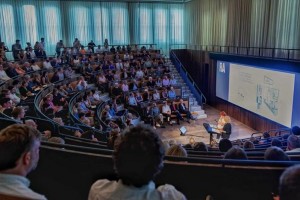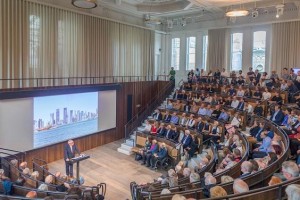Aktuelle News & Schlagzeilen
Sound Space Vision delivers solution to Royal Academy transformation
In 2012 Sound Space Vision (SSV) became the theatre design and acoustics consultant for David Chipperfield Architects’ master plan to unite the Royal Academy of Arts’ 18th century Burlington House with its neighbour, Burlington Gardens, and transform the interiors throughout.
SSV’s brief was to modernise and equip Burlington Gardens’ 19th-century lecture theatre for 21st century presentation and performance, and this was later expanded to include acoustics advice on the new gallery spaces and the learning centre, as well as mechanical systems.
The form of the new lecture theatre went through several iterations; common to all being the reduction in height from three to two storeys. The form settled on a tight, almost semi-circular, bowl with a steep rake for a total capacity of over 250, bringing audience and presenter into close communication.
The combination of windows on all sides and a listed historic interior at first floor level presented SSV with two specific challenges: to find projectors and a screen that would be usable in daylight, and to provide sufficient acoustic dampening to overcome the natural reverberance of the volume of space which hinders good speech intelligibility. Associated with this was the choice and location of loudspeaker to serve the bowl-like audience.
SSV devised a package including lighting bars that hang discreetly on three sides of the room to light speakers’ faces without shadows. An infrastructure of lighting and AV connectivity is available at three levels around the room - in the ceiling, the balcony floor and the stage floor.
Edge-blended projectors support large format art presentations with colour rendering and facilitate in-house broadcasts and web casts. A digital audio system provides amplification and pick-up for recording, streaming, hearing assistance and interpretation. Digital column array loudspeakers provide clarity in a reverberant acoustic.
SSV continuously reviewed the technical specifications through the long design and build process to ensure the infrastructure serves a wide range of capabilities. Sound absorbing solutions to control reverberation time involve sheer, sound-absorbing curtains that pass daylight and perforated leather for the bench seating accounting for some of the considerable mitigation of noise.
Isolation from external noise and internal building services was also required, alongside MEP and AV systems that would not disturb nearby residents. This was achieved with heavy, acoustically-treated secondary glazing to the windows and the roof light, and a specification that the mechanical plant adjacent to the theatre should rest on a floating concrete slab to limit noise and vibration. The proximity of the neighbours and risk of intrusive breakout noise (plant and events) was mitigated by way of low velocity, high attenuation ventilation paths, including an under-seat plenum.
In addition to this, SSV delivered several detailed environmental acoustics assessments of the rooftop plant for submission to the local authority, and associated MEP services noise and vibration control design advice.
(Photos: Benedict Johnson/Simon Menges)
SCHLAGZEILEN
news archiv
suche
© 1999 - 2025 Entertainment Technology Press Limited News Stories










